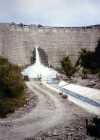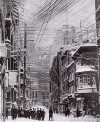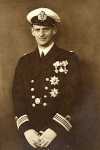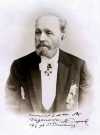 Constructed between 1924 and 1926, the St. Francis Dam was a concrete gravity-arch dam designed to act as a reservoir to store water for the Los Angeles Aqueduct. In 1928, the dam catastrophically failed, and the resulting flood of 12 billion US gallons (45 billion liters) of water killed more than 450 people. The dam’s collapse was the worst American civil engineering failure of the 20th century and remains the second-greatest loss of life disaster in California’s history, after what event? Discuss
Constructed between 1924 and 1926, the St. Francis Dam was a concrete gravity-arch dam designed to act as a reservoir to store water for the Los Angeles Aqueduct. In 1928, the dam catastrophically failed, and the resulting flood of 12 billion US gallons (45 billion liters) of water killed more than 450 people. The dam’s collapse was the worst American civil engineering failure of the 20th century and remains the second-greatest loss of life disaster in California’s history, after what event? Discuss
Source: The Free Dictionary
 The Bok Kai Festival is a two-day event in
The Bok Kai Festival is a two-day event in .jpg) Boycott was the estate agent for the Earl of Erne, an absentee landowner in County Mayo, Ireland, at a time when the Irish Land League was pressing for agrarian reform. In 1880, Boycott’s refusal to reduce rents for tenant farmers, combined with his attempted eviction of 11 of them, led the League to launch a campaign of ostracism and isolation—now known as a “boycott”—against him and his family. Upon finding himself suddenly without servants, farmhands, or local services, Boycott did what?
Boycott was the estate agent for the Earl of Erne, an absentee landowner in County Mayo, Ireland, at a time when the Irish Land League was pressing for agrarian reform. In 1880, Boycott’s refusal to reduce rents for tenant farmers, combined with his attempted eviction of 11 of them, led the League to launch a campaign of ostracism and isolation—now known as a “boycott”—against him and his family. Upon finding himself suddenly without servants, farmhands, or local services, Boycott did what?  A meme is an idea, thought, or piece of information that is passed from generation to generation through imitation and behavioral replication. The terms memes and memetics, coined by Richard Dawkins in his 1976 book The Selfish Gene, are the cultural counterpart to the biological study of genes and genetics. In his book, Dawkins hypothesizes that human cultures evolve via “contagious” communications in a manner similar to the gene pools of populations. What is a memeplex?
A meme is an idea, thought, or piece of information that is passed from generation to generation through imitation and behavioral replication. The terms memes and memetics, coined by Richard Dawkins in his 1976 book The Selfish Gene, are the cultural counterpart to the biological study of genes and genetics. In his book, Dawkins hypothesizes that human cultures evolve via “contagious” communications in a manner similar to the gene pools of populations. What is a memeplex?  The Great Blizzard of ’88 was one of the most severe blizzards in US history. Snowfalls of 40 to 50 in (102 to 127 cm) fell in parts of New Jersey, New York, Massachusetts, and Connecticut, and snowdrifts exceeded 50 ft (15 m) in some places. Railroads were shut down, and people were confined to their houses for up to a week. More than 400 people died from the storm and the ensuing cold, including 200 in New York City alone. What infrastructure changes were made in the aftermath of the storm?
The Great Blizzard of ’88 was one of the most severe blizzards in US history. Snowfalls of 40 to 50 in (102 to 127 cm) fell in parts of New Jersey, New York, Massachusetts, and Connecticut, and snowdrifts exceeded 50 ft (15 m) in some places. Railroads were shut down, and people were confined to their houses for up to a week. More than 400 people died from the storm and the ensuing cold, including 200 in New York City alone. What infrastructure changes were made in the aftermath of the storm?  Though no longer observed, the birthday of
Though no longer observed, the birthday of  The principal creator of the modern classical ballet, Petipa was a French-born Russian dancer and choreographer. He received early training from his ballet-master father and was a dancer in France, Belgium, and Spain before joining the Imperial Theatre in St. Petersburg, where he created several ballets and became chief choreographer in 1869. By his retirement in 1903, he had produced more than 60 ballets for the imperial theatres in St. Petersburg and Moscow, including what performances?
The principal creator of the modern classical ballet, Petipa was a French-born Russian dancer and choreographer. He received early training from his ballet-master father and was a dancer in France, Belgium, and Spain before joining the Imperial Theatre in St. Petersburg, where he created several ballets and became chief choreographer in 1869. By his retirement in 1903, he had produced more than 60 ballets for the imperial theatres in St. Petersburg and Moscow, including what performances?  An automat is a fast food restaurant where food and drinks are served by coin- and bill-operated vending machines. Joseph Horn and Frank Hardart opened the first automat in the US in 1902 and quickly popularized the notion of take-out food with their slogan “Less work for Mother.” The original automat machines, which had little windows containing the prepared meals, were filled from behind by workers who cooked the fresh food in an unseen kitchen. What led to the decline of automat dining?
An automat is a fast food restaurant where food and drinks are served by coin- and bill-operated vending machines. Joseph Horn and Frank Hardart opened the first automat in the US in 1902 and quickly popularized the notion of take-out food with their slogan “Less work for Mother.” The original automat machines, which had little windows containing the prepared meals, were filled from behind by workers who cooked the fresh food in an unseen kitchen. What led to the decline of automat dining?